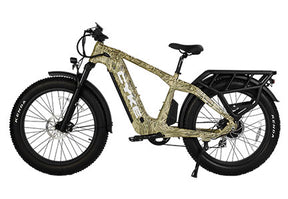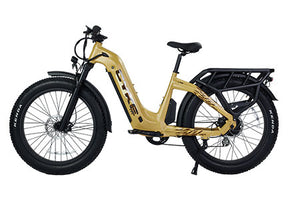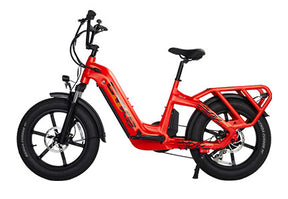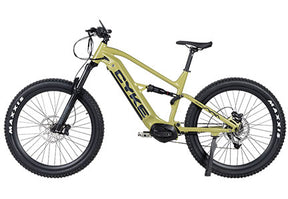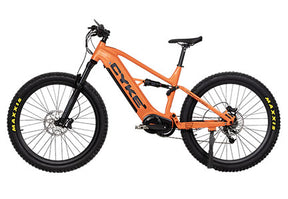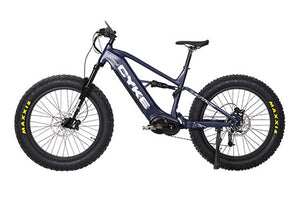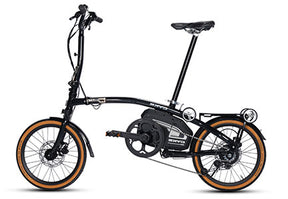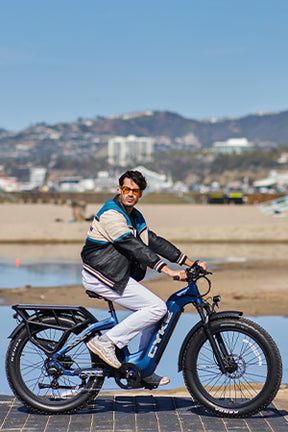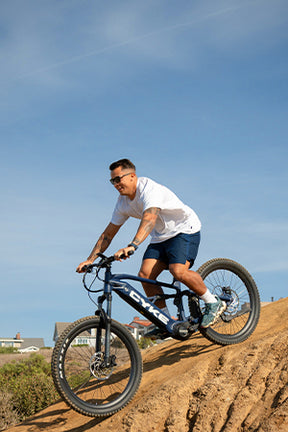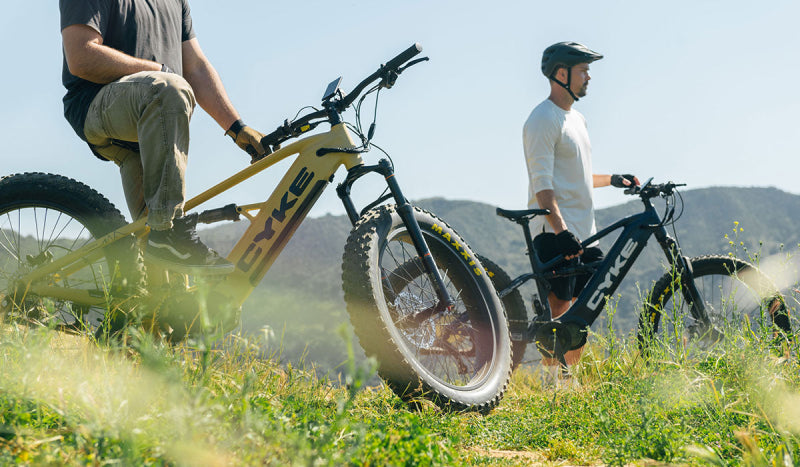Featured in this posts
Keep Moving in Cold Months - Guides for Warm Cycling
As winter wraps its icy grip around us, the urge to hibernate can be strong. However, staying active is crucial for both physical and mental well-being. Embracing the challenge of winter cycling with ebikes not only keeps the wheels turning but unlocks a myriad of benefits. In this article, we'll delve into the importance of staying active during winter, explore the challenges and benefits of cycling with ebike in cold weather, and highlight key aspects of warm cycling.

Riding Your Ebike During Cold Winter: How to Get Prepared?
Riding your ebike in the cold might seem daunting, but with the right preparation, it can be an exhilarating experience. Getting ready for winter cycling involves a thoughtful approach to dressing for warmth and safety, as well as implementing effective safety measures. Let's delve into these crucial aspects to ensure you're geared up for a safe and enjoyable ride.
Dressing for Warmth and Safety
- Layering Techniques for Cold Weather
Mastering layering is key to conquering the cold during winter rides. Begin with a moisture-wicking base layer to keep sweat away from your body, preventing chilling. Add insulating mid-layers like fleece or down to trap heat. Finally, don a windproof and waterproof outer layer to shield against icy winds and potential rain or snow. This layering strategy provides flexibility to adjust your clothing based on the fluctuating temperatures during your ride.
- Extremity Protection
Cold extremities can quickly turn an enjoyable ride into an uncomfortable one. Insulated gloves are a must to shield your hands from biting cold winds. Shoe covers help retain warmth in your feet and protect against moisture, ensuring a more comfortable journey. Don't forget a thermal hat or headband to keep your ears and head warm, crucial areas for maintaining overall body heat.
- Reflective Clothing and Lights
Winter days often come with reduced daylight, and riding in the dark becomes a reality. Enhance your visibility with reflective clothing, and well-placed lights on your ebike. Reflective vests, jackets, or even strips added to your attire significantly increase your visibility to motorists and pedestrians. Ensure your ebike is equipped with front and rear lights, and consider additional side lights for comprehensive visibility.
Safety Measures and Winter Cycling Tips
- Staying Visible and Alert
Visibility is paramount during winter rides, especially in dim or adverse weather conditions. Wear brightly colored clothing to stand out against the winter landscape. Additionally, strategically placed reflective elements on your bike and clothing ensure you catch the eye of others on the road. Stay alert to your surroundings, anticipate potential hazards, and adjust your riding style accordingly.
- Carrying the Right Cycling Gear and Supplies
Preparedness is your ally during winter cycling. Pack essential gear such as a multi-tool, spare tubes, and a pump to handle potential mechanical issues. A first aid kit, hand warmers, and extra layers can be a lifesaver in unexpected situations.
Before riding, ensure your phone is fully charged and consider bringing a power bank for longer rides. Always remember to keep a keen eye on the weather forecast and tailor your gear accordingly, adding or removing layers of clothes as needed.
How To Preparing Your Ebike for Winter?
-Do not leave your ebike battery in the cold
You should not leave a lithium battery in a cold environment for longer than necessary. When the battery is placed in a cold environment, usually below 5-10°C, it will not work properly. And at low temperatures, batteries become less efficient and less powerful than usual. So keep the battery inside the room as much as possible, keep it warm, and make sure it delivers the best performance possible.
Do not charge the battery when the temperature is very low, such as around 10°C or below freezing. If the battery must be charged, use a lower current.
Moreover, charging at low temperatures reduces battery quality over time. If the battery will not be used in a cold environment, let it warm up slowly before charging
-Replace your tires with wider, more resistant models
There are a lot of options available when it comes to winter tires. When the roads are slippery, you want your tires to have enough grips. Try fat tires at this time, as they are more sturdy, provide better grips, and absorb bumps better. With a small search, you can find all types and find what suits your electric bike.
-Add more lights on your ebike
Even if you won’t be out after dark normally, a sudden change of plan sometimes may increase the likelihood that you'll find yourself stranded at some point.
Since not having lights on after sunset is quite dangerous and even illegal, it makes sense to leave a set permanently attached to your bike during the winter, and at the very least, a bright headlight and a taillight.
-Check your electric bike chain
Whatever type of ebike you have, you need to check the chain. Regular chain maintenance is essential to achieve optimal performance of your bike and avoid problems. How often you clean and lubricate your bike chain depends on your electric bike riding style and the type of trail you ride on, but we recommend doing this every season and certainly in the winter months for greater protection against water and snow.
-Test your brakes
Winter knows when there are wet leaves or snow on the ground, one of the most important safety features on your bike is the brakes. To make sure the brakes are working properly, try pressing the brake lever against the handlebar. Pay close attention to whether there is any problem with the braking method and whether it makes any sounds or noises.
Riding Techniques for Winter Conditions
1-Adjust your riding style and speed
When driving on snowy or icy surfaces, it is important to reduce speed and brake carefully. This will help you maintain control of your ebike and avoid slipping. Be especially careful when braking, as it may be easy to lock the wheels on slippery surfaces. To be more cautious, take a short test ride in a place with fewer cars to see how your bike handles.
2-Adjust your braking technique
In snowy conditions, braking requires extra care. Avoid making sudden stops, and start braking earlier than you would on dry pavement.
Use the front and rear brakes equally to maintain control. When in doubt, use your rear brake though. You can move the back wheel easily, but locking the front wheel can put you sideways in the blink of an eye!
3-Choose the right routes
Think about your route before you head out, especially in unpredictable winter conditions. Roads that typically feature bike lanes can become unsuitable for bikes when the lanes become packed with snow, forcing cyclists into traffic-clogged lanes where cars already suffer from poor traction. This is why you should prepare alternative routes, such as another bicycle path, and be prepared to be out for a longer period than expected.
Also remember that snow plows frequently sweep the roads, so be vigilant, as these drivers may experience limited visibility as well.
4-Ride carefully
Increasing of speed is one of the advantages of riding an electric bike, but in some winter weather conditions such as snow and ice, you need to slow down.
Ride like a tortoise, not like a hare. Remember, the turtle still got there, even earlier. So take your time, and know that take-off will have to be a little slower.
Remember that roads can be unpredictable, so be alert at all times, keep your eyes on the road ahead, and expect your trips to take longer than usual because you will be driving slower.
Post-Ride Care and Storage
- Cleaning and Drying Your Ebike
Keep your electric bike clean. If possible, clean them after each ride using bike-specific cleaners. Do not use spray washing as this may dislodge grease and will pressurize water into the internal parts which may corrode essential components.
Clean all the dirt from your frame, then wipe it with a dry cloth. Be sure to ensure that the battery contacts are clean and dry to prevent corrosion. Next, lubricate the chain to protect it and turn the pedal to rotate the chain ensuring the lube circulates around the system.
- Indoor Storage and Protection
The electrical devices and components in ebikes are sensitive to temperature and humidity extremes. Store in a cool, dry place, away from high humidity. An outdoor garage or shed is a good idea depending on where you live. The ideal storage temperature is between 32°C and 68°C.
While your bike will stay dry during the long winter months in your garage or outdoor shed, the biggest enemy of your electric bike and its components is high humidity. This will still cause some rust and possible corrosion over time. Therefore, it’s better to send it to professionals for examination regularly.
Summary
Don’t worry, with proper preparations, precautions and maintenance during the winter period, you can undoubtedly ride your electric bike comfortably and safely throughout the winter. Although cold temperatures and inclement weather present driving challenges, they can be overcome.
Follow the recommendations in this guide, including protective clothing, caution based on road conditions, regular winter cycling gear, and proper battery storage.
Don't let the cold temperatures prevent you from enjoying your hobby and sporting activity, pack your bags and go out on exhilarating winter tours. Be sure to shop CYKE for the best electric bikes and gear that will keep you moving all winter long, safely and comfortably!
